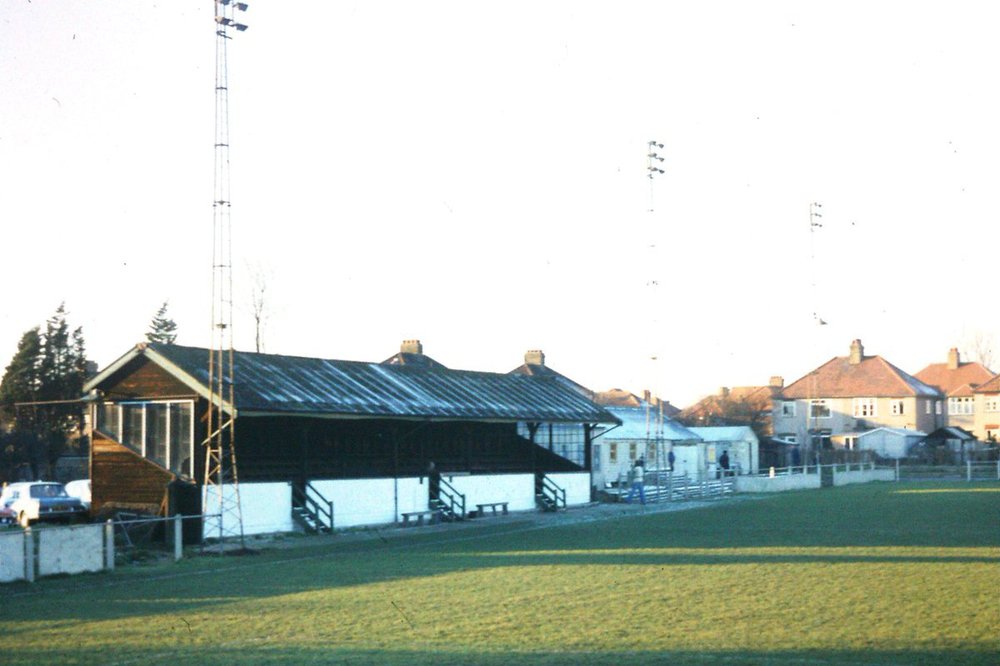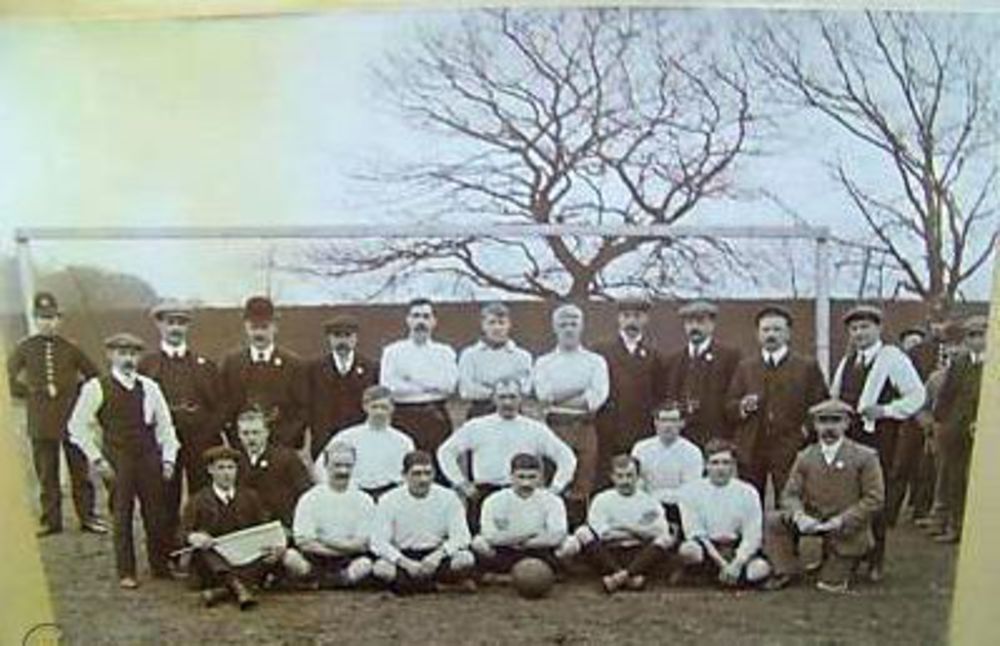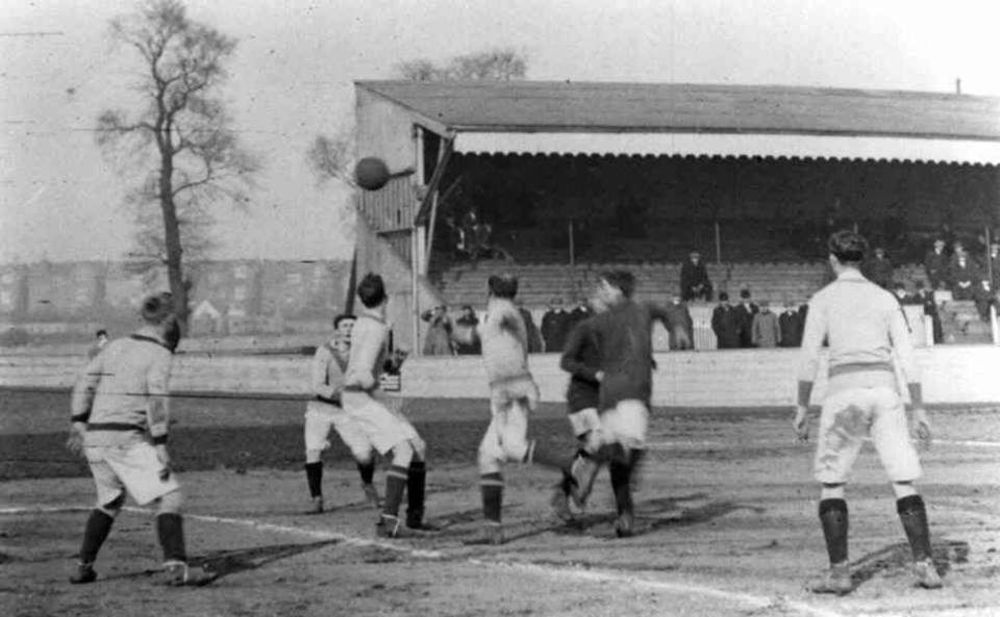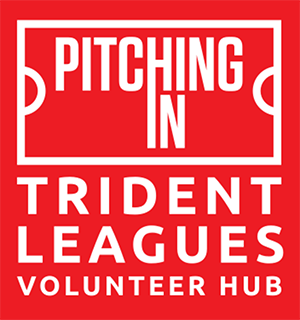
Hounslow FC ground
Although there was a Hounslow club around at the turn of the 20th century playing in the London League, the more modern version, originally named Hounslow Town, started up just after the Second World War.
They started out in the Corinthian League and were very successful.
They were league champions in 1949/50 and 1951/52. They were champions again in 1954/55 and also reached the First Round of the FA Cup, where they lost 4–2 at home to Hastings United.
At the end of the season, they joined the Athenian League and finished as runners-up in their first season and were champions in 1959/60.
In 1961/62 the club reached the FA Amateur Cup Final at Wembley where they took on mighty Northern League side Crook Town.
After a 1–1 draw, they lost the replay at Middlesbrough`s Ayresome Park 4–0.
The following season, as Amateur Cup finalists, they were given direct entry to the First Round of the FA Cup, holding Mansfield Town to a 3–3 draw at home, before losing 9–2 away.
During their days as amateurs and as Hounslow Town, the club had some very good players pass through their ranks.
In 1908, left-back Fred Bullock left Hounslow for Ilford and was then signed by First Division Huddersfield Town in 1910 but the First World War intervened.
Bullock was wounded in the right shoulder during the Battle of the Somme in 1916.
He was injured in the left knee after an accident in 1918 and was demobbed in March 1920 when he resumed his Huddersfield career.
Already an England Amateur international, Bullock won one full cap at the age of 34 - a 2-0 victory against Ireland in the Home Internationals in October 1920.
Sadly, a few months after retiring, having made 202 appearances for Huddersfield, Bullock died at the age of 36 of ammonia poisoning, found dead by his wife in the pub they ran in Halifax.
In 1966 the club was re-named Hounslow.
In 1968/69 the club finished bottom of the Athenian League Premier Division and were relegated to Division One.
They went on to finish bottom of Division One in both 1970/71 and 1971/72 but remained in the league until 1977 when they joined Division One South of the Southern League.
During their brief Southern League days, Hounslow introduced the likes of Keith Osgood, who went on to play over 100 times for Tottenham Hotspur, Ernie Howe, the ex-Fulham and QPR defender, Tony Spencer, who played for Brentford and Clevere Forde, a talented winger who was signed by Malcolm Allison for Plymouth Argyle but found the step-up difficult and chances limited across the two seasons he was with the club.
He later moved back into non-League football with Wealdstone, Wycombe Wanderers, Harrow Borough and Barnet.
After finishing bottom of the Southern Division in 1983/84, Hounslow were relegated to the Premier Division of the Hellenic League.
They were runners-up in 1986/87 and were promoted back to the Southern League. However, they were relegated again in 1989/90 and returned to the Hellenic League.
In 1991 the club lost its Denbigh Road ground to the council, which built a school on the site.
They then merged with Feltham to form Feltham & Hounslow Borough with the new club playing in the Isthmian League. However, the merged club reverted to the name Feltham in 1995, thus the name of Hounslow disappeared.
There are several clubs that had short spells in the Southern League and in most cases, short existence as clubs.
Eastleigh Athletic were formed by workers at the Eastleigh Railway Depot in the early 1890s and were originally known as Eastleigh LSWR (London & South Western Railway).
The club owned their own sports ground at Dutton Lane in the Hampshire town, which over the years was developed with an oval cycling track and grandstand for spectators.
In 1896 they adopted their best-known identity of Eastleigh Athletic and were one of the eight founder members of the Hampshire League.
In September 1896 they took part in a historic match against Freemantle - the first-ever game of the new competition.
In 1897/98, they were league champions and Hampshire Senior Cup winners, after a 2-1 victory against the 2nd Gordon Highlanders (Aldershot).
The final was played at the County Ground, Southampton in front of a large crowd.
To generate a full fixture list, in those days it was common for clubs to enter more than one league during the same season and in 1897/98 Eastleigh also entered a side in the Western League (Professional Section).
Also playing in this eight-team Division were Swindon Town, Reading, Bristol City and Bristol Rovers - Eastleigh finished in 7th place.
The following season they then joined the Southern League Division Two (South West Section), finishing fifth out of six clubs, but on the scrapping of this short-lived division, the main focus switched back to the more realistic Hampshire League.
They continued until the club dissolved in 1967.
The first reference to West Hampstead FC was in 1895, and in 1897 they joined Division Two of the London League.
They were elected to Division Two of the Southern League for the 1901/02 season, winning 6 of their 16 league matches.
However, they left the league at the end of that season.
They remained a registered club though, without being in a league, and in 1903/04 lost 4-2 to Dorset side Whiteheads in the FA Amateur Cup and in 1905/06 they reached the Fourth Qualifying Round of the FA Cup, losing to Swindon Town but weren`t heard of after that.
Cwm Albion was a Welsh club based in Cwm, Monmouthshire.
They joined Division Two of the Southern League in 1911 at a time when the league contained several clubs based in South Wales.
They played at a basic ground, which was accessed by crossing two fields.
The ground was not enclosed, and many fans watched matches from surrounding picturesque Welsh hillsides.
The home team changed in the village, whilst the away team changed in a disused cowshed.
After one match the referee was chased by Cwm supporters, who threw him into the river.
After sheltering in a house, the referee was escorted to the railway station by police!
Their season in the Southern League was disrupted by the 1912 coal strike, and four matches were left un-played.
The club was forced to leave the league shortly before the end of the season due to financial problems and finished second from bottom of the table and duly disappeared.
Gloucestershire-based Warmley FC were formed in 1882.

They are widely regarded as playing the first organised football match in the Bristol region against St George.
Alongside Clifton, St George and Eastville Rovers they were founder members of the Gloucestershire FA and were were also one of the founding members of the Bristol & District League (now the Western League) in 1892, winning the title four times in their history.
With the advent of professionalism in the Western League in 1897, St George approached Warmley with a proposal to merge the two clubs.
The feeling among members of St George was that Bristol was not large enough to support four professional clubs (Bristol City, Eastville Rovers, Warmley and St George) and that by pooling their resources a new merged team would be the strongest club in the city.
Warmley, however, rejected the proposal and the merger never took place.
In 1896, Warmley joined the Second Division of the Southern League, before both Bristol City and Bristol Rovers.
The 1897/98 season saw the club finishing in second place to Royal Artillery (forerunners to Portsmouth) in the process becoming the first team in the Southern League to score 100 goals in a season.
The club now competed in the First Division alongside other Bristol sides City and Bedminster.
But only seventeen matches were completed before the club folded in February 1899.
Southern United was a club based in the Nunhead area of London.
Established in 1905, the club entered teams into Division Two of the Southern League and Division One of the London League.
They withdrew from the Southern League at the end of the 1905/06 season, and from the London League during the 1906/07 season.
However, despite their short time in the league, they did manage to produce outside left Fred Spiksley, who won seven full international caps for England just before the turn of the 20th century.
Professional players at the club included Frederick Mearns, Michael Good and former England international Fred Spiksley.
An interesting character, he went on to become one of the first Englishmen to manage abroad, taking charge of Swedish sides Norrkoping and Stockholm and also having a year in charge of the Swedish national side in 1911.
Thames AFC were founded in 1928 to play on a ground which had no football club in residence.
In Thames' case, they were formed by a group of businessmen who had built the West Ham Stadium, with a capacity of 120,000, in the Custom House area of Essex (now part of the London Borough of Newham in Greater London).
The stadium was primarily used for greyhound and speedway racing which took place during the week, leaving Saturdays free.
The directors of the stadium decided to form a professional football club to play on Saturdays, to bring in additional revenue to the stadium.
The club began playing in the Southern League Eastern Division in 1928/29, and finished 14th in their first season and third the season after that.
This was enough for them to gain election to the Football League Third Division South in the summer of 1930, in place of Merthyr Town.
Their request to join the league was considered alongside applications from York City, Connah's Quay, Mansfield Town and Prescot Cables.
The success of their application required them to suddenly upgrade the quality of the team. To achieve this objective, the newly promoted club placed an advert for `First Class Players Wanted. All Positions` in the June edition of the Athletic News.
Thames continued to field a reserve side in the Southern League for a single further season, before withdrawing entirely in 1931.
Thames' spell in the Football League was a short and unhappy one. The club struggled to attract spectators. It established a supporter`s group, which at one point had over 1,000 members. However, this effort did not translate into a reliable supporter base that would regularly attend matches.
Despite the stadium's capacity of 120,000 (making it the largest ground in England to regularly host League football), the club holds the record for the lowest known attendance for a Saturday Football League match when just 469 fans paid to watch Thames play Luton Town in December 1930.
Unable to compete with established teams, Thames struggled and by December 1931, the club was under severe financial pressure.
To keep the club afloat, the players agreed to take a pay cut and they finished 20th out of 22 clubs in 1930/31 and bottom the following season.
This prompted the club directors' decision not to seek re-election to the Football League for the following season and wind up the club, despite an approach from Clapton Orient to merge the two clubs.
Aldershot replaced them.
Like the other clubs with short-lived spells in the Southern League, Thames possessed some notable players, including former England international Jimmy Dimmock, who made over 400 appearances for Tottenham Hotspur and score more than 100 goals to earn three caps, and former Welsh internationals Len Davies, Moses Russell and Eddie Perry.
Thornycrofts FC were an amateur club, based in Southampton.
The club was formed by employees of John I. Thornycroft & Company, the Woolston-based shipbuilders.

Formed in 1917, the club joined the Hampshire League.
In 1920/21 they decided to turn professional and join the Southern League.
However, the club finished 13th out of 13, winning only four games from 24 played and resigned after just one season as a Southern League club.
They subsequently returned to the Hampshire League and played regularly in the qualifying rounds of the FA Cup and in 1920 took First Division Burnley to a replay.
Croydon Common and not Crystal Palace, were the first professional football club to be based in the borough of Croydon.
Prior to the First World War, the club played in the Southern League.
They were Southern League Division Two champions in 1908/09 and gained promotion to Division One.
But in 1910, Common were relegated.
Nineteen of the twenty clubs in Division One of the Southern League at the outbreak of war in 1914 later became long-term members of the Football League. The only one not to do so was Croydon Common!

The club was always in financial trouble and, when it finally folded in 1917, its ground in Selhurst, known as `The Nest`, was taken over by local rivals Crystal Palace and used until Selhurst Park was built.
The club had some memorable moments in its short life, such as beating Bradford Park Avenue of the Football League away in the FA Cup and taking Arsenal (then Woolwich Arsenal, but already well established in the top-flight) to a replay in the same competition in both 1909 and 1913.
Former Croydon Common players of note include William Balmer and Sam Wolstenholme, who both won England international caps – Balmer against Ireland at Everton alongside Wolstenholme, who won two others.
Harold Hadley was also capped once by England against Ireland at The Hawthorns, Ernie Williamson won two caps in three days, both against Sweden in 1923 whilst on Arsenal`s books and Jack Harrow, then with Chelsea, also win two caps – one in the same side as Williamson against Sweden and the other a year earlier against Ireland.
Croydon Common also produced Welsh international Bob Evans and Scottish cap Dave Gardner.

Most clubs are looking for volunteers. Find out more on the button below:
www.PitchingInVolunteers.co.ukAll the news and results in one place.
REGISTER